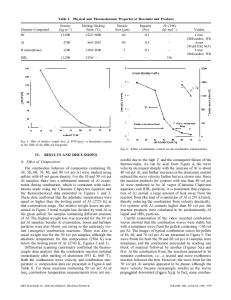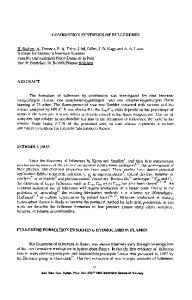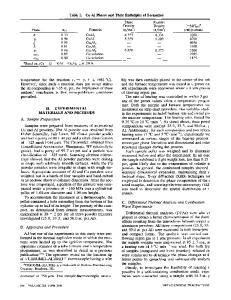Reaction steps in the combustion synthesis of NiAl/TiB 2 composites
- PDF / 897,911 Bytes
- 6 Pages / 612 x 792 pts (letter) Page_size
- 104 Downloads / 338 Views
I. INTRODUCTION
THE reaction synthesis (RS) process, also known as self-propagating high-temperature synthesis or combustion synthesis[1,2,3] has been widely used to produce a variety of materials. Single compounds such as NiAl, TiC, TiB2, and MoSi2 are currently being produced, as well as composites such as NiAl/TiC,[4] TiC/Al203/Al,[5] and TiB2/SiC.[6] These materials are used in applications that involve high temperatures and/or require high wear resistance; they may be used as cutting tools or as targets for physical vapor deposition. The main advantage of the RS process over other processes such as powder metallurgy, infiltration, and other conventional routes relies on the fact that part of the energy required to achieve the desired product phases and densification is generated by an exothermic chemical reaction. The main disadvantage with respect to the fabrication of dense structural composites is that the inherently violent nature of the reaction typically results in porous microstructures; full densification may be achieved by simultaneous RS and hot pressing. The RS process can be operated in two modes: the propagating mode and the simultaneous thermal-explosion mode. In the first case, the green pellet is heated locally, at the surface, at which a reaction takes place. The heat generated in this first layer triggers the reaction in the adjacent layer, and the combustion wave is propagated through the whole sample. In the simultaneous-combustion mode, the reaction takes place simultaneously in the whole sample and, therefore, the experiment can be conducted in a hot-press facility. Generally, the propagation mode is more applicable for producing porous materials, where the goal is to maximize the volume of pores, e.g., B4C/Al2O3 for bone replacements.[7] On the other hand, the simultaneous-combustion mode is R.D. TORRES, formerly Graduate Student with the Metallurgical and Materials Engineering Department, Colorado School of Mines, is Associate Professor, Catolic Universit of Parana´, Parana´, Brazil. I.E. REIMANIS, Associate Professor, and J.J. MOORE, Professor and Head, Metallurgical and Materials Engineering Department, and G.G.W. MUSTOE, Associate Professor, Engineering Division, are with the Colorado School of Mines, Golden, CO 80401. Manuscript submitted March 19, 1999. METALLURGICAL AND MATERIALS TRANSACTIONS B
best used when high-density materials are required, e.g., TiC for cutting tools. The NiAl/TiB2 composites studied here have potential applications as high-temperature structural materials, since the addition of TiB2 particles to NiAl can increase the strength by a factor of 3 at temperatures between 1200 and 1300 K.[8,9,10] This improvement in strength has been attributed to subgrain formation in the NiAl matrix together with a high dislocation density. The room-temperature fracture toughness also has been improved by addition of TiB2 to NiAl. An increase from 5.4 (pure NiAl) to 9.0 MPa?m1/2, depending on the TiB2 particle size and distribution, has been reported.[10] In the current work,
Data Loading...











